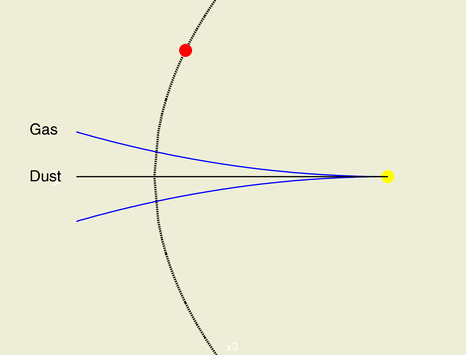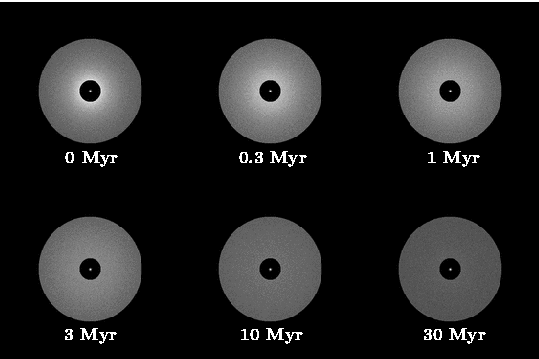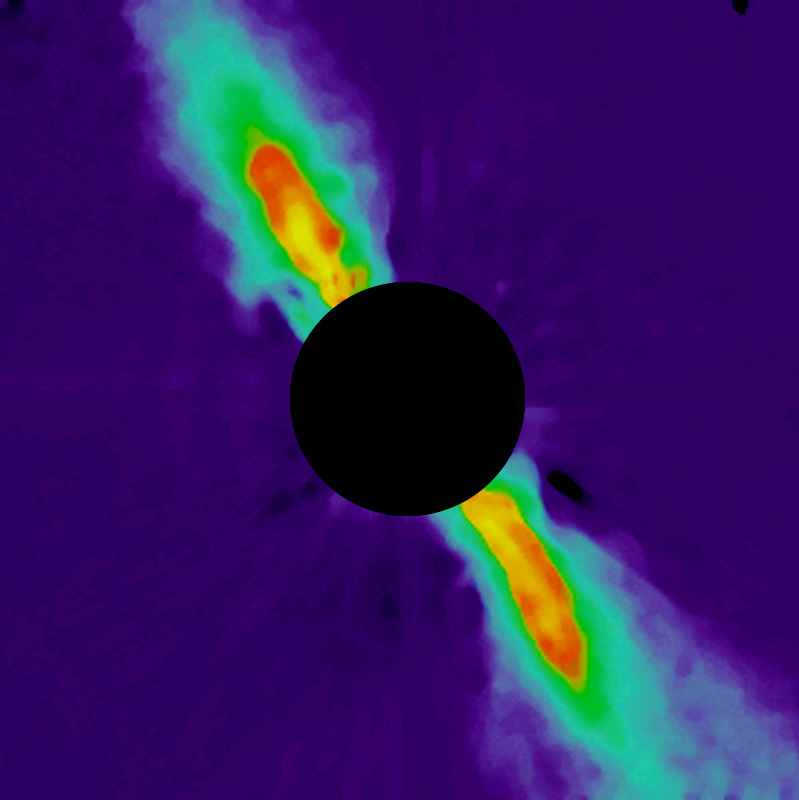STELLAR FLYBYS & PLANETARY DEBRIS DISKS
Scott Kenyon (SAO) & Benjamin Bromley (Utah)
Background
Many nearby main sequence stars have thermal emission from cold dust. The near-infrared and far-infrared excess emission is 1% or less of the stellar luminosity. These debris disk systems often have disks or rings of dust with radii of 50-1000 AU. The rings and disks are at least as large as the disk of our solar system.
In current theories, dynamic processes produce dust emission in a debris disk. Measurements of the disk radiation indicate that the disks contain small dust grains with sizes of 1-100 micrometers and a total mass in small grains of 0.01 Earth masses. However, radiation removes small grains from the disk on timescales of 1-10 Myr (million years). Most debris disk systems are 10 Myr old or older. Thus, the grains disappear relatively quickly.
Collisions between larger bodies can replenish the small grain population when their relative velocities are large enough to begin a collisional cascade, where 1-10 km objects called planetesimals are ground down into smaller and smaller bodies. Planetesimals with sizes of 1-10 km probably shatter at velocities of 200 m/sec. If the mass in 1-10 km planetesimals is roughly 100 Earth masses, collisional cascades can maintain the observed small grain population observed in debris disks for 100 Myr or longer.
At least two mechanisms can produce large collision velocities in a debris disk.
Our Project
We study the evolution of a planetesimal disk perturbed by a stellar flyby using a multiannulus planetesimal evolution code.
We start with a portion of a disk of planetesimals in orbit around a star. We divide the disk into a set of concentric annuli and model the collisions between planetesimals in neighboring annuli.
We can follow the evolution of particles with sizes ranging from 1-10 cm (an inch or so) up to the Earth. We track the rate and outcomes of collisions between particles with different sizes. We also calculate perturbations in the orbits of planetesimals from other planetesimals in the disk.
We use modern supercomputers at the JPL supercomputing center to calculate the evolution of the disk of planetesimals. A typical calculation takes a few weeks of computer time.
The Flyby
The figure below shows a schematic of the flyby. A yellow star is surrounded by a gaseous disk. The planetesimals and most of the dust lie in a thin layer at the midplane of the disk. The gas extends above and below the dust. Small particles are probably trapped in the gas.

A red star passes through the disk on a parobolic trajectory. This star perturbs the orbits of the planetesimals. The perturbation is large if the star passes close to the disk and is small if the star passes far away from the disk. We assume a close passage - within about 500-1000 AU - which instantaneously perturbs the planetesimal orbits.
Our Calculations
During and after the flyby, planetesimals collide and shatter. Shattering produces smaller planetesimals that also collide and shatter. This cascade of collisions produces more and more small dust grains.
Like the dust grains that shine in a sunbeam coming through your window, small dust grains produced in the collisional cascade reflect light from the central star. The amount of light reflected by the grains depends on the number of grains: more grains reflect more light. In a planetesimal disk, the grains are so numerous that their reflected light can be observed on Earth, as a disk of dusty debris around a nearby star.
As more and more dust grains are produced, their collective collisions damp the planetesimals and cause them to move at smaller velocities. The damping time is roughly 1 Myr for a disk with a mass in solid material (rocks and ice) comparable to the mass in our solar system. According to our calculations, a disk with 1% of this minimum mass solar nebula damps in 100 Myr.
Once collisions start to damp the velocities of planetesimals, colliding planetesimals tend to merge instead of fragment. More mergers and few fragments produce less dust. Fewer dust grains reflect less light from the central star. In our calculations, the dust luminosity is proportional to the amount of mass in the disk. The damping time is inversely proportional to the mass of the dust. Thus the product of the luminosity and the damping time is a constant:
In our calculations, the dust luminosity is roughly 1% of the luminosity of the central star when the disk mass is comparable to the minimum mass solar nebula. Current instruments can detect dust luminosities equal to 0.001% of the stellar luminosity for nearby stars like Vega and Fomalhaut. A planetesimal disk with an observable amount of dust fades below current detection limits in 1-10 Myr.
Most planetary debris disk systems have ages of 100 Myr or longer. Unless stellar flybys are more common than we think, a passing star probably did not produce the dust we see in most debris disk systems. Embedded planets or a nearby binary companion star are probably responsible for the collisional cascades in most systems.
Images
To construct predicted images of a planetesimal disk, we derive the dust luminosity as a function of distance from the central star. We then assign intensities to pixels in a square image based on their radial distance from the center of the disk. We add noise to the image to simulate a real observation. The noise is the square root of the intensity. The image below shows a montage of images constructed at six different times in the evolution of a disk.

After the Flyby
To see if planets form after a flyby, we continued these simulations for a variety of initial conditions. As long as the collisional does not grind all of the planetesimals to dust, planets eventually form in the disk. Planet formation takes 2-4 times longer after a flyby.




